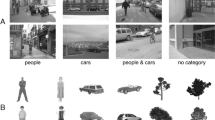Abstract
Here, this author attempts to tie the concept of active perception to attentive processing in general and to the complexity level analysis of visual search described previously; the aspects of active vision as they have been currently described form a subset of the full spectrum of attentional capabilities. Our approach is motivated by the search requirements of vision tasks and thus we cast the problem as one of search preceding the application of methods for shape-from-X, optical flow, etc., and recognition in general. This perspective permits a dimension of analysis not found in current formulations of the active perception problem, that of computational complexity. This article describes where the active perception paradigm does and does not provide computational benefits along this dimension. A formalization of the search component of active perception is presented in order to accomplish this. The link to attentional mechanisms is through the control of data acquisition and processing by the active process. It should be noted that the analysis performed here applies to the general hypothesize-and-test search strategy, to time-varying scenes as well as to the general problem of integration of successive fixations. Finally, an argument is presented as to why this framework is an extension of the behaviorist approaches to active vision.
Similar content being viewed by others
References
Abbott, A., and Ahuja, N. 1988. Surface reconstruction by dynamic integration of focus, camera vergence and stereo. Proc. 2nd Intern. Conf. Comput, Vision, December, Tarpon Springs FL, pp. 532–543.
Aloimonos, J., Weiss, I., and Bandyopadhyay, A. 1987. Active vision, Proc. Ist Intern. Conf. Comput. Vision, London, pp. 35–54.
Bajcsy, R. 1985. Active perception vs. passive perception. Proc. IEEE Workshop on Computer Vision: Representation and Control, October, Bellaire MI, pp. 55–62.
Ballard, D. 1985. Task frames in visuo-motor coordination. Proc. IEEE Workshop on Computer Vision: Representation and Control, October, Bellaire MI, pp. 3–10.
Ballard, D. 1987. Eye movements and visual cognition. Proc. IEEE Workshop Spatial Reasoning and Multi-sensor Fusion, St. Charles IL, October, pp. 188–200.
Ballard, D. 1989. Animate vision. Proc. 11th Intern. Joint Conf. Artif. Intell., Detroit
Ballard, D., and Ozcandarli, A. 1988. Eye fixation and early vision: Kinetic depth. Proc. 2nd Intern. Conf. Comput. Vision, Tarpon Springs, FL, pp. 524–531.
Bandyopadhyay, A., Chandra, B., and Ballard, D. 1986. Active navigation: Tracking an environmental point considered beneficial. Proc. IEEE Workshop on Motion: Representation and Analysis, Charleston, SC, May, pp. 23–28.
BrooksR. 1986. A layered intelligent control system for a mobile robot. IEEE J. Robot. Autom. RA-2: 14–23, April.
Clark, J.J., and Ferrier, N. 1988. Modal control of an attentive vision system. Proc. 2nd Intern. Conf. Comput. Vision, December, Tarpon Springs, FL, pp. 514–523.
Connell, J. 1989. “A Colony Architecture for an Artificial Creature.” MIT AI Lab, Ph.D. Thesis, AI-TR1151.
Freuder, E. 1976. “A Computer System for Visual Recognition Using Active Knowledge.” Ph.D. thesis; also AI-TR-345, MIT AI Lab, June.
GareyM., and JohnsonD. 1979. Computers and Intractability: A Guide to the Theory of NP-Completeness. W.H. Freeman: New York.
GibsonJ.J. 1979. The Ecological Approach to Visual Perception. Houghton Mifflin: Boston.
Grimson, E. 1988. The combinatorics of object recognition in cluttered environments using constrained search. Proc. 2nd Intern. Conf. Comput. Vision, Tampa, FL, pp. 218–227.
HelmholtzH.von, 1910. Hanbuch der physiologischen detlk. English translation, J. Southall, Dover: New York, 1925.
KrotkovE. 1987. Focusing, Intern. J. Comput. Vision 1: 223–237.
LaBergeD. 1990. Attention. Psychological Science 1–3, 156–162.
LeeperR. 1935. A study of a neglected portion of the field of learning: The development of sensory organization. J. Genet. Psychol. 46: 41–75.
MarrD. 1982. Vision. W.H. Freeman: New York.
MetzgerW. 1974. Consciousness, Perception and Action. Handbook of Perception, vol. 1, Historical and Philosophical Roots of Perception. Academic Press, San Diego, CA, pp. 109–125.
NakayamaK., and MackebenM. 1989. Sustained and transient components of focal visual attention. Vision Research 29(11): 1631–1647.
ParasuramanR., and DaviesD., (editors). 1984. Varieties of Attention. Academic Press: Orlando, FL.
Paul, R., Bajcsy, R., et al. 1987. The integration of sensing with actuation to form a robust intelligent control system. GRASP LAB 97, Dept. of Computer and Information Science, University of Pennsylvania, March.
RabbittP. 1978. Sorting, categorization and visual search. In The Handbook of Perception: Perceptual Processing, Vol.IX, edited by E.Carterette and M.Freidman. Academic Press: New York.
SteinmanR. 1986. Eye movement. Vision Research 26(9):1389–1400.
TreismanA. 1988. Features and objects: The Fourteenth Bartlett Memorial Lecture. Quart. J. Exp. Psychol. 40A(2):201/237.
TsotsosJ.K. 1988. A ‘complexity level’ analysis of immediate vision. Intern. J. Comp. Vision 1(4):303–320.
Tsotsos, J.K. 1989. The complexity of perceptual search tasks. Proc Ilth Intern. Conf. Artif. Intell., pp. 1571–1577, Detroit.
TsotsosJ.K. 1990a. A complexity level analysis of vision. Behav. Brain Sci. 13(3):423–455.
TsotsosJ.K. 1990b. A little complexity analysis goes a long way. Behav. Brain Sci. 13(3):459–469.
TsotsosJ.K. 1991. Is complexity analysis appropriate for analyzing biological systems? Behav. Brain Sci. 14(4):770–773.
UhrL. 1990. Some important constraints on complexity. Behav. Brain Sci. 13(3):455–456.
VervilleE., and CameronN. 1946. Age and sex differences in the perception of incomplete pictures in adults. Pedagogical Seminary 68:149–157.
Author information
Authors and Affiliations
Rights and permissions
About this article
Cite this article
Tsotsos, J.K. On the relative complexity of active vs. passive visual search. Int J Comput Vision 7, 127–141 (1992). https://doi.org/10.1007/BF00128132
Issue Date:
DOI: https://doi.org/10.1007/BF00128132




